The Automatic Content Recognition Market is estimated to be valued at USD 3.3 billion in 2025 and is projected to reach USD 11.4 billion by 2035, registering a compound annual growth rate (CAGR) of 13.1% over the forecast period.
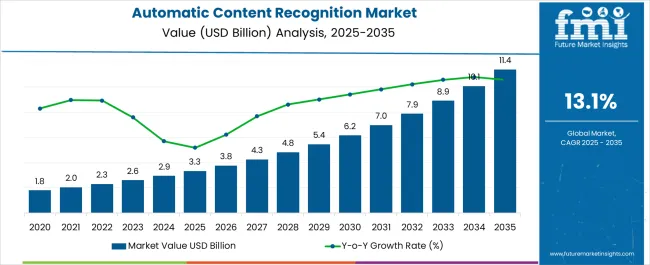
| Metric | Value |
|---|---|
| Automatic Content Recognition Market Estimated Value in (2025 E) | USD 3.3 billion |
| Automatic Content Recognition Market Forecast Value in (2035 F) | USD 11.4 billion |
| Forecast CAGR (2025 to 2035) | 13.1% |
The automatic content recognition (ACR) market is evolving rapidly, driven by increasing demand for data-driven decision-making, audience measurement, and interactive media engagement. As digital content consumption continues to surge across streaming platforms, smart TVs, and second-screen devices, ACR technologies are being adopted to enable real-time content identification and audience behavior analysis.
Enhanced integration with cloud platforms and AI-powered engines has strengthened the ability to process large volumes of audio and video metadata for real-time applications. Regulatory trends supporting transparency in media ratings and privacy-compliant tracking have further catalyzed enterprise interest in ACR.
Media companies, advertisers, and broadcasters are leveraging ACR to enhance viewer targeting, reduce content piracy, and improve personalized content delivery. Going forward, market expansion is expected to be influenced by connected device penetration, advancements in audio watermarking and fingerprinting, and strategic collaborations between content distributors and technology vendors.
The market is segmented by Solution and End-User Industry and region. By Solution, the market is divided into Real-time Content Analytics, Voice & Speech Recognition, Security & Copyright Management, Data Management & Metadata, and Other. In terms of End-User Industry, the market is classified into Media & Entertainment, IT & Telecommunication, Consumer Electronics, Healthcare, and Other. Regionally, the market is classified into North America, Latin America, Western Europe, Eastern Europe, Balkan & Baltic Countries, Russia & Belarus, Central Asia, East Asia, South Asia & Pacific, and the Middle East & Africa.
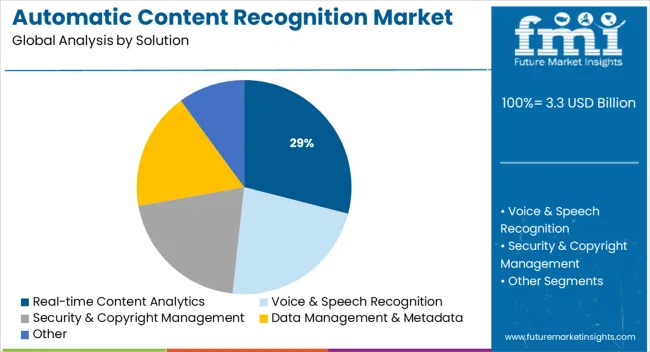
Real-time content analytics is projected to account for 29.0% of the total revenue share in the ACR market by 2025, making it the leading solution segment. This segment’s dominance is being driven by its ability to deliver instant insights into viewer engagement, content performance, and advertising reach.
Broadcasters and streaming platforms are increasingly prioritizing solutions that can process live audio-visual streams, enabling dynamic ad insertion, content optimization, and rapid decision-making. Real-time analytics has also become central to content security and compliance, especially in live sports and event broadcasting.
The rise in connected TVs and smart devices has created demand for edge-based processing, where real-time ACR plays a crucial role in reducing latency and improving user interactivity. As personalization and second-screen engagement continue to reshape viewer expectations, the value of real-time content analytics in content monetization and strategy refinement is expected to remain high.
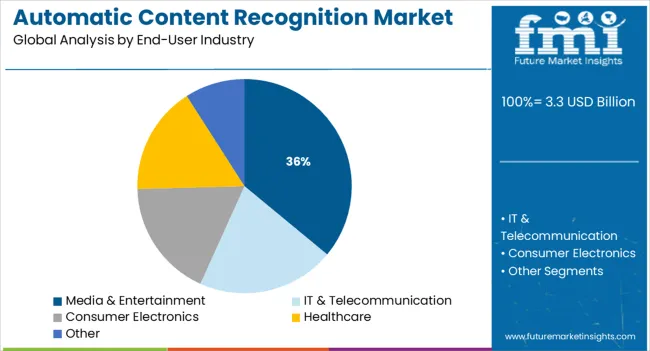
The media and entertainment sector is expected to hold 36.0% of the total ACR market share in 2025, positioning it as the leading end-user industry. This leadership is being fueled by the sector's reliance on accurate audience insights, anti-piracy technologies, and interactive content delivery systems.
ACR enables media companies to track content consumption across platforms, facilitating targeted advertising and enhancing viewer personalization. Increased investment in over-the-top (OTT) platforms, interactive TV formats, and digital broadcasting has expanded the application of ACR in monitoring viewing patterns and improving engagement metrics.
Moreover, real-time viewer behavior data supports programmatic advertising and helps optimize content placement and scheduling. As the competitive landscape intensifies and monetization strategies evolve, ACR is being viewed as an essential tool to drive operational efficiency and audience retention in the media and entertainment domain.
As per the Global Automatic Content Recognition Market research by Future Market Insights - a market research and competitive intelligence provider, historically, from 2020 to 2024, the market value of the Automatic Content Recognition Market increased at around 16.6% CAGR. Global demand for automatic content identification solutions has increased as a result of the advent of automatic content recognition technologies in smart TVs and smartphones.
The increasing use of automatic content identification by media companies for audience assessment and broadcast monitoring is also expected to fuel the growth of the global market for autonomous content recognition. Due to the rise of smart devices such as smartphones, televisions, and wearables, there is a growing demand for content identification, recognition, and augmentation among enterprises and end users.
The usage of automatic content recognition systems and services by businesses led to a range of ways in which life hacking has become simpler. By launching music recognition software that combined digital fingerprinting technology, Shazam established the trend.
Many companies adopted this strategy and released second-screen apps for smart TVs and smartphones that were based on automatic content identification. The popularity of on-demand video platforms like Netflix, Hotstar, YouTube, and Amazon Prime has increased the need for automatic content detection tools and services.
Smart TVs provide a wide range of increased processing and networking capabilities. Advanced functions on smart TVs include searching, talking, browsing, sharing, upgrading, and downloading. TV viewership in India climbed by 12% in 2020, according to the Broadcast Audience Research Council (BARC). Smartphones account for 70% of total online traffic; hence, content reorganization is critical for material synchronization and preserving uniformity and consistency of data.
The rising popularity of social media on smartphones is increasing demand for the Automatic Content Recognition market. The growing usage of second-screen devices, such as smartphones and wearables, for tracking unlawful users is propelling the market growth. According to a Netflix poll, more than 70% of its programs are viewed on smartphones and tablets rather than TVs.
The expanding number of viewers on YouTube and other social media sites necessitates a review of the overall number of viewers captured, resulting in a necessity for automatic content identification technologies. For example, in 2020, 1.8 Billion people utilized Facebook on a daily basis. The market is also projected to be driven by several manufacturers delivering innovative technologies for Automatic Content Recognition. Zeitera, a pioneer in digital audio and video fingerprinting technology, has developed a patented audio-video content identification and search system for smart TVs, smartphones, and tablets.
Data is a critical aspect that most businesses struggle to manage. It serves as the foundation of automatic content recognition technologies. Due to the inability to manage exabytes and petabytes of data, the risk of security breaches and data loss has increased. In order to avert breaches, businesses will need more comprehensive security and privacy protection as IoT becomes more ubiquitous.
The issue of security jeopardizes the advancement of digitalization. In today's competitive sector, marketing teams require real-time and secure data to create an amazing customer experience. Data is collected and virtually measured by organizations through a variety of touchpoints. The data types include public information, huge data, and customer-supplied microdata.
Watermarking and digital fingerprinting, two of the most often utilized automatic content identification technologies, have a few drawbacks that cause serious financial issues. The usage of digital fingerprinting has drawbacks in that users can change the data.
However, there are even more fundamental issues with digital watermarking that provide significant difficulties for businesses using it for automatic content recognition. Including the watermark in the material adds a diversion to the media file in addition to altering the properties of the original file. As opposed to fingerprinting, watermarking offers a more secure method of identification.
During the projection period, North America is expected to be the largest Automatic Content Recognition Market. Every day, around 3.5 billion individuals use search engines to find information. As a result, Automatic Content Recognition is required for content identification and augmentation.
The improved healthcare infrastructure influences the demand for audio and visual identification technology. Furthermore, the expanding automobile sector in the USA and Canada is influencing the demand for speech recognition to improve communication systems integrated into automobiles, such as phone calls, audio devices, and navigation.
In 2020, Canada's automotive industry, for example, featured 1,085 car manufacturers and 1,275 manufacturing facilities. As a result, the demand for voice recognition to do several automated tasks in a vehicle has increased.
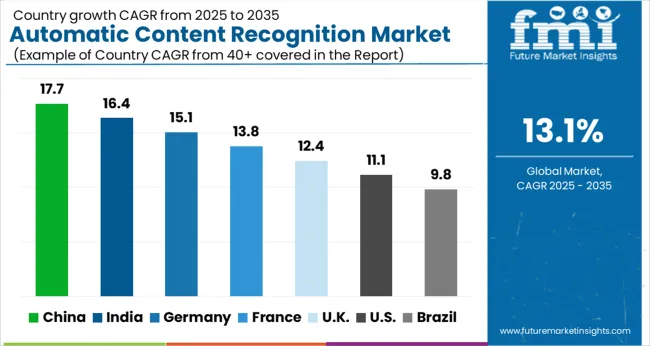
The USA is expected to account for the highest market of USD 11.4 Billion by the end of 2035. Also, the market in the country is projected to account for an absolute dollar growth of USD 1.8 Billion. In the USA, face, and speech recognition is utilized to collect and store data in electronic health records. As a result, various manufacturers developing software for the healthcare sector are expected to support market growth. For example, DrChrono released an Electronic Health Record in November 2020 that uses Apple's facial recognition to preserve electronic records. Drchrono contains around 10 Million patient medical records, which represents approximately 3% of the US population.
Market revenue through media and entertainment is forecasted to grow at a CAGR of over 12.9% from 2025 to 2035. The highest market share is served by media and entertainment. Automatic Content Recognition technology captures a few pixels of whatever the user is currently watching on TV.
The data is subsequently transferred to the TV manufacturer's Automatic Content Recognition tracking program, which analyzes a variety of parameters. Automatic Content Recognition technology is available on websites where audiovisual content has already been verified. This can positively affect the development of applications targeting this market. Cell phones are becoming increasingly popular. For example, about 1.8 Billion& smartphone users globally increased demand for the automatic content recognition market in 2020.
Various suppliers offer music-listening programs that synchronize the content using Automatic Content Recognition. Mufin GmbH, for example, is a prominent provider of automatic content recognition for Android apps when listening to music.
Second-screen devices such as smartphones, tablets, and laptops are used by consumers to view TV shows and listen to music. Automatic Content Recognition synchronizes data and sends real-time information to the second screen user, paving the way for an automated content recognition market. According to Netflix survey data, more than 24% of the population watches television on a second screen.
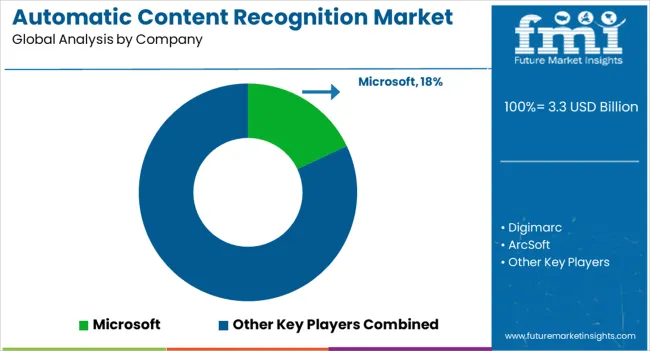
Players in the market are constantly developing improved analytical solutions as well as extending their product offerings. The companies in the Automatic Content Recognition Market are focused on their alliances, technology collaborations, and product launch strategies.
Some of the recent developments of key Automatic Content Recognition providers are as follows:
Similarly, recent developments related to companies in Automatic Content Recognition Market have been tracked by the team at Future Market Insights, which are available in the full report.
The global automatic content recognition market is estimated to be valued at USD 3.3 billion in 2025.
The market size for the automatic content recognition market is projected to reach USD 11.4 billion by 2035.
The automatic content recognition market is expected to grow at a 13.1% CAGR between 2025 and 2035.
The key product types in automatic content recognition market are real-time content analytics, voice & speech recognition, security & copyright management, data management & metadata and other.
In terms of end-user industry, media & entertainment segment to command 36.0% share in the automatic content recognition market in 2025.






Our Research Products

The "Full Research Suite" delivers actionable market intel, deep dives on markets or technologies, so clients act faster, cut risk, and unlock growth.

The Leaderboard benchmarks and ranks top vendors, classifying them as Established Leaders, Leading Challengers, or Disruptors & Challengers.

Locates where complements amplify value and substitutes erode it, forecasting net impact by horizon

We deliver granular, decision-grade intel: market sizing, 5-year forecasts, pricing, adoption, usage, revenue, and operational KPIs—plus competitor tracking, regulation, and value chains—across 60 countries broadly.

Spot the shifts before they hit your P&L. We track inflection points, adoption curves, pricing moves, and ecosystem plays to show where demand is heading, why it is changing, and what to do next across high-growth markets and disruptive tech

Real-time reads of user behavior. We track shifting priorities, perceptions of today’s and next-gen services, and provider experience, then pace how fast tech moves from trial to adoption, blending buyer, consumer, and channel inputs with social signals (#WhySwitch, #UX).

Partner with our analyst team to build a custom report designed around your business priorities. From analysing market trends to assessing competitors or crafting bespoke datasets, we tailor insights to your needs.
Supplier Intelligence
Discovery & Profiling
Capacity & Footprint
Performance & Risk
Compliance & Governance
Commercial Readiness
Who Supplies Whom
Scorecards & Shortlists
Playbooks & Docs
Category Intelligence
Definition & Scope
Demand & Use Cases
Cost Drivers
Market Structure
Supply Chain Map
Trade & Policy
Operating Norms
Deliverables
Buyer Intelligence
Account Basics
Spend & Scope
Procurement Model
Vendor Requirements
Terms & Policies
Entry Strategy
Pain Points & Triggers
Outputs
Pricing Analysis
Benchmarks
Trends
Should-Cost
Indexation
Landed Cost
Commercial Terms
Deliverables
Brand Analysis
Positioning & Value Prop
Share & Presence
Customer Evidence
Go-to-Market
Digital & Reputation
Compliance & Trust
KPIs & Gaps
Outputs
Full Research Suite comprises of:
Market outlook & trends analysis
Interviews & case studies
Strategic recommendations
Vendor profiles & capabilities analysis
5-year forecasts
8 regions and 60+ country-level data splits
Market segment data splits
12 months of continuous data updates
DELIVERED AS:
PDF EXCEL ONLINE
Automatic Chicken Deboning Machine Market Size and Share Forecast Outlook 2025 to 2035
Automatic Filter Press Solutions Market Size and Share Forecast Outlook 2025 to 2035
Automatic Filter Presses (AFPs) Market Size and Share Forecast Outlook 2025 to 2035
Automatic Riveting Equipment Market Forecast and Outlook 2025 to 2035
Automatic Powder Forming Machine Market Forecast and Outlook 2025 to 2035
Automatic Weigh Price Labeling Machine Market Size and Share Forecast Outlook 2025 to 2035
Automatic Bending Machine Market Size and Share Forecast Outlook 2025 to 2035
Automatic Transmission Market Size and Share Forecast Outlook 2025 to 2035
Automatic Emergency Braking System Market Size and Share Forecast Outlook 2025 to 2035
Automatic Impact Testing Machine Market Size and Share Forecast Outlook 2025 to 2035
Automatic Glue Machine Market Size and Share Forecast Outlook 2025 to 2035
Automatic Floodgate Market Size and Share Forecast Outlook 2025 to 2035
Content Analytics Discovery And Cognitive Systems Market Size and Share Forecast Outlook 2025 to 2035
Automatic Die Cutting Machines Market Size and Share Forecast Outlook 2025 to 2035
Automatic Dependent Surveillance-Broadcast (ADS-B) System Market Size and Share Forecast Outlook 2025 to 2035
Automatic Silver Sintering Die Attach Machine Market Size and Share Forecast Outlook 2025 to 2035
Automatic Emergency Braking (AEB) Market Size and Share Forecast Outlook 2025 to 2035
Content Delivery Network Industry Analysis in Korea Size and Share Forecast Outlook 2025 to 2035
Content Analytics Software Market Size and Share Forecast Outlook 2025 to 2035
Content Delivery Network Industry Analysis in Western Europe Size and Share Forecast Outlook 2025 to 2035

Thank you!
You will receive an email from our Business Development Manager. Please be sure to check your SPAM/JUNK folder too.
Chat With
MaRIA